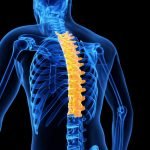Fracture Thoracic and Lumbar Spine
Breakdown: What It Is
A spinal fracture is a serious injury.  The most common fractures of the spine occur in the thoracic (midback) and lumbar spine (lower back) or at the connection of the two (thoracolumbar junction). These fractures are typically caused by high-velocity accidents, such as a car crash or fall from height.
The most common fractures of the spine occur in the thoracic (midback) and lumbar spine (lower back) or at the connection of the two (thoracolumbar junction). These fractures are typically caused by high-velocity accidents, such as a car crash or fall from height.
Men experience fractures of the thoracic or lumbar spine four times more often than women. Seniors are also at risk for these fractures, due to weakened bone from osteoporosis.
Because of the energy required to cause these spinal fractures, patients often have additional injuries that require treatment. The spinal cord may be injured, depending on the severity of the spinal fracture.
Potential Causes
Fractures of the thoracic and lumbar spine are usually caused by high-energy trauma, such as:
- Car crash
- Fall from height
- Sports accident
- Violent act, such as a gunshot wound
Spinal fractures are not always caused by trauma. For example, people with osteoporosis, tumors, or other underlying conditions that weaken bone can fracture a vertebra during normal, daily activities.
Treatment Options
Nonsurgical treatment is based on comfort level. Extension fractures that occur only through the vertebral body can typically be treated nonsurgically; these should remain in a brace or cast for 12 weeks, under close observation.
If there is an injury to the posterior (back) ligaments of the spine, surgery is typically necessary. The patient may benefit from a vertebroplasty. If the fracture falls through the disks of the spine, surgery will be required to stabilize it.

